Topic/Category
Year
Topic/Category
Year
24 April 2024
In recent years, several experts and advocacy organisations have proposed incorporating labels identifying ultra-processed foods (UPFs) into front-of-pack labelling (FOPL) schemes. UPFs, as defined by the Nova classification system, consist of formulations that contain little to no whole food ingredients, are assembled using intense industrial processing methods (including physical, chemical, and biological processing), and usually contain flavourings and cosmetic additives such as colourings, aromas, and emulsifiers.
A US-based study (1) aimed to examine whether front-of-package “ultraprocessed” labels on packaged food influence the perceptions of adults. An online experiment of 600 US adults viewed a product under three labelling conditions (control, “ultraprocessed” label, and “ultraprocessed” plus “high in sugar” label) in random order for a single product. See Figure 1.
Results showed that the “ultraprocessed” label led participants to think more about the risks of eating the product and discouraged them from wanting to buy the product more than the control, despite not grabbing more attention than the control. The “ultraprocessed” plus “high in sugar” labels caught more attention, led participants to think more about the risks of eating the product, and discouraged them from wanting to buy the product more than the “ultraprocessed” label alone.
The authors concluded that “ultraprocessed” labels may create promising messages that could work in addition to nutrient labels, and further research should examine how they would influence consumers’ intentions and behaviours.
A key limitation of this study is that it was a small online experiment with a single product, therefore it is not possible to generalise the findings in different settings and with different products. The sample also included a larger proportion of women than men. Lastly, the results were not adjusted for some demographic characteristics such as rurality or anthropometric measures, which would be worth including in future studies.
